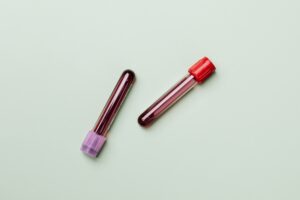The full blood count is one of the commonest blood investigations. That provides information about cells and other components in your blood circulation. To fully understand the components analyzed in a full blood count test, you must first get a brief idea about the composition of blood.
Our blood is consisting of various types of cells. It includes red blood cells, white blood cells, and platelets. The main function of red blood cells is the transportation of oxygen to all tissues of the body. It is mainly done by the protein molecules found inside red blood cells known as hemoglobin. The main function of white blood cells is to protect your body from infections and strengthen your immune system. Platelets are important to initiate the clotting mechanism of blood. And to stop bleeding. Plasma is the fluid compartment of blood and it carries nutrients, vitamins, hormones, and many important components throughout the body.
Components of Full Blood Count

- Red blood cell count – The number of red blood cells per volume of blood is analyzed.
- White blood cell count – The number of white blood cells per volume of blood is analyzed. There are various kinds of white blood cells in our body: Neutrophils, Lymphocytes, Monocytes, Basophils, and Eosinophils. The amount of each cell type is analyzed during this test as it is important to identify some specific diseases.
- Hemoglobin count – The amount of hemoglobin which is the protein responsible for carrying oxygen in the blood is calculated.
- Platelet count – The number of platelets per volume of blood is analyzed.
- Hematocrit – The amount of volume taken up by the red blood cells as a percentage of the entire blood volume.
- Mean corpuscular volume (MCV) – A measure that indicated the average size of your red blood cells.
- Mean corpuscular hemoglobin (MCH) and Mean corpuscular hemoglobin concentration – Respectively the amount and concentration of the oxygen-binding protein ( hemoglobin ) in a red blood cell
Why is it Done?
Normally your medical officer will recommend you get a full blood count done in order to get a basic idea of the health status of your body. And is also performed as a part of routine health checkups. It provides information about a huge variety of disorders including diseases of the immune system, infective disorders, disorders of red blood cells, blood carcinomas, and many other medical conditions specially related to blood.
It is also done in order to monitor the effect on blood cells caused by some medications and radiation. Also, if you are a diagnosed patient of any kind of a blood-related disease you will need to undergo routine full blood count tests. It will help to monitor the progression of your disease and to intervene before the occurrence of complications.
How Can You Interpret the Results of Full Blood Count?
Identifying the diseases we can interpret using the results of a full blood count test is important.
- Red cell count, hemoglobin and hematocrit abnormalities indicate a disorder of red blood cells. Lower levels than the normal range indicate Anemia, which includes abnormally low levels of hemoglobin in your body. This can be due to many conditions such as nutritional deficiencies, blood loss, or structural abnormalities in red blood cells. You might feel shortness of breath, tired or weak if you have anemia and an initial diagnosis of it can be made through a full blood count. Higher levels than the normal range indicate blood cancers and heart diseases.
- White blood cell count – Higher levels than the normal range is a very common abnormality that can be identified in this test and it indicated an infection (most commonly a bacterial infection) or an inflammatory condition. Also, other conditions such as blood cancers, immune system disorders, and reactions to some medications or hard exercise can cause an increase in white cell counts although not common. Low levels of white blood cell count may indicate autoimmune disorders, bone marrow problems, and cancers.
- Platelet count – Abnormalities of platelet count may indicate medical conditions of platelets, bleeding disorders, or side effects of some medications.
How to Prepare for the Test?
Usually, this test doesn’t need any preparations as fasting. But if you are recommended to get done any other blood investigations along with a full blood count you will have to stay fasting and be prepared which will be informed to you in advance by your medical officer.
How Is the Procedure Done?
Normally the person who takes the blood sample will initially clean your arm and then insert a needle. Usually, blood is taken from the medial aspect of the middle of the arm or in infants by pricking a finger or the heel. Generally venous blood is taken for this test. Initially, needle may sting or pinch a little, but it doesn’t hurt a lot. By inserting the needle your medical officer will remove a sample of blood, and collect blood into a tube. After that the needle will be slowly removed while placing a bandage on your arm. Furthermore sample taken from you will be sent to the hematology laboratory for analysis.
After the test is done the pinched site will be covered by a piece of gauze on your arm, secured by a tape. You will feel sore around the site of injection for a few hours and later you may develop a small bruise at the injection site. You can return to your usual activities right after the test is performed.

What Are the Complications of this Test?
This test is a safe investigation with fewer complications. As a very small amount of blood is removed from your body which is replaced within a few days by your body there is no risk for you. But rarely some people may get fainted or feel lightheaded after or during the procedure.
Limitations of the Full Blood Count
This test alone is not enough to reach a conclusive diagnosis of many disorders. The main limitation of this test is less specificity which might lead you to undergo many other investigations in the process of disease diagnosis.
References
• Kumar and Clerk’s Clinical Medicine -8th Edition- Parveen Kumar, Michael Clark
• Oxford Handbook of Clinical Medicine – 10th Edition

